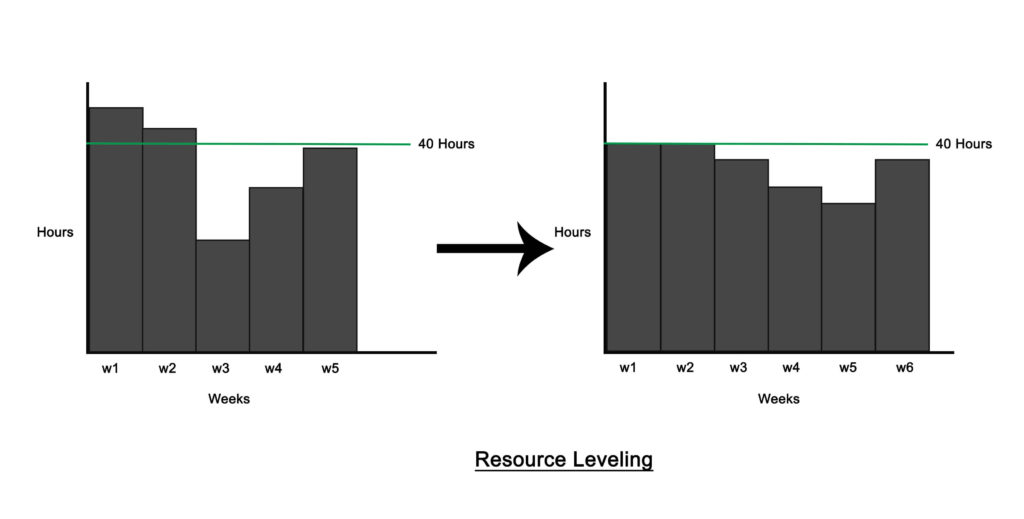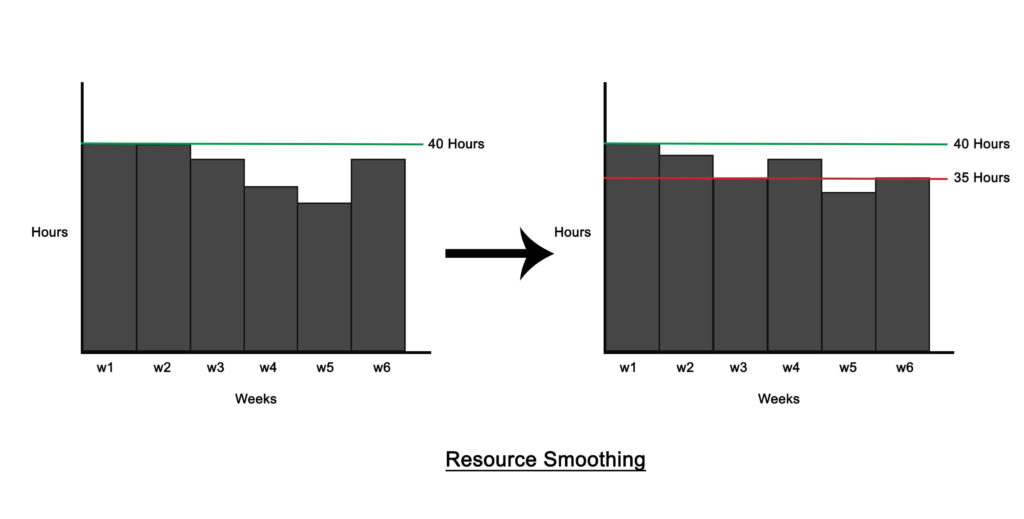This blog post will discuss the difference between Resource Leveling Vs Resource Smoothing.
It rarely happens that you have all resources to complete the project. Even if you have them, during project execution, any risk can take away that freedom, and you will have to manage with fewer resources.
Even when you have all the necessary resources, as a project manager, it is your responsibility to use resources efficiently and save costs for the company.
To achieve these objectives, you use resource optimization techniques. Two such resource optimization techniques are as follows:
- Resource Leveling
- Resource Smoothing
These techniques allow you to complete the project with minimal obstruction.
Resource Leveling Vs Resource Smoothing
Let’s start with resource leveling.
Resource Leveling

You use resource leveling when you have limited resources, and you may extend the schedule.
Resource leveling is used when:
- A critical resource may not be available for a certain duration;
- A critical resource may not be available at a certain point in time;
- You have to share a resource with another project;
- The demand for a resource exceeds the supply.
You also use this technique when you must keep some resource usage at a constant level.
In resource leveling, you are asked to optimize the limited resources given to you. Here the schedule is not fixed.
Resource leveling answers when you can complete the project with the given resources.
Resource leveling is sometimes called resource constrained scheduling (RCS). If resources are not available, the project duration may change.
A Real World Example
Let’s say you are developing a schedule for a project to construct a two-story building. You have enough scaffolding to construct the first floor but need extra scaffolding for the second floor.
So you look within your organization and find that you can arrange extra scaffolding from another project one week later than you require.
So, you delay construction activities on the second floor by one week.
This is an example of resource leveling, where you extend the schedule to get the resource.
Resource Smoothing

You use resource smoothing when optimizing the resources and cannot extend the schedule.
Since you cannot extend the schedule, the project completion date and the critical path will stay the same. Here the activities cannot be delayed more than their total and free float.
Using float in this technique will cause you to lose some flexibility from your path; however, the schedule will be optimized, efficient, and cost-effective.
In resource smoothing, you must be careful to avoid any delay in activity as it may affect your critical path.
Time is the main constraint here. You have a fixed schedule and are asked to optimize resources.
Resource smoothing is also known as time constrained scheduling (TCS). The project end date cannot be changed, and you have to optimize resources within the float.
A Real World Example
Let’s say you want to apply for the PMP exam and have allocated 60 hours to study in three months. This translates to 20 hours per month.
However, while scheduling the date for the exam, you find that the only available appointment is in four months. Now you must distribute these 60 hours throughout four months, meaning 15 hours per month.
This is an example of resource smoothing. Since you have enough time, using all 60 hours in three months is unnecessary. You can ease the burden of these three months and use the fourth month.
Difference Between Resource Leveling and Resource Smoothing
The following are a few differences between resource leveling and resource smoothing:
- The project end date may change in resource leveling, while in smoothing, it does not change.
- In resource leveling, the critical path changes (generally increases), while in resource smoothing, it does not, and activities can be delayed within their float.
- Generally, resource smoothing is usually performed after the resource leveling.
- In resource leveling, resources are the main constraint, while in resource smoothing, the project end date is a constraint.
- Resource leveling is used when resources are under or over allocated. Resource smoothing is used when resources are unevenly allocated.
- Resource leveling can be applied to activities on the critical path, while in resource smoothing, you do not touch activities on the critical path.
Similarities Between Resource Leveling and Resource Smoothing
The following are a few similarities between these two techniques:
- They both help you optimize resource utilization
- They both help you in scheduling network analysis
Resource leveling and resource smoothing are different techniques used in different situations. It is not always necessary to use both methods; in this blog post, I mentioned that resource smoothing usually happens after resource leveling.
This is not true in all cases; you may use either or both. However, if you are using both, resource leveling is usually followed by resource smoothing.
Summary
Resource smoothing and resource leveling are two resource optimization techniques that increase the chance of completing the project within the approved cost and schedule baselines if used in any project. Resource leveling balances the demand and supply of resources, and resource smoothing helps ensure uniform resource utilization. These techniques are also used due to statutory or regulatory requirements. Either way, these techniques help you optimize your resources in your project.
Have you implemented resource leveling or resource smoothing? If yes, I would love to hear about your experience in the comments section.

Illustrated quite lucidly !!, keep it up ! all the good luck.
Thanks Mr. Kirnalli.
we always use leveling resource on my work.
Hello Tahseen, can you share more information it?
Wonderfully explained. I really love reading your blogs to gain absolute clarity of confusing terms Thanks !
You are welcome Ajay.
Very good explanation of resource leveling & smoothing
Thanks Moshahed for your visit and leaving comment.
Thank you
You are welcome Ahmed.
Excellent clarification .. many thx
You are welcome Wasef.
Thank you, Mr. Fahad for this great illustration.
You are welcome Fadwa.
Wow! This expose’ is technically informing, I’ve gotten missing techniques in developing my project schedules. Thanks and more of that, sir.
Very very clear, precious clarification.
Thanks for sharing important information.
Good luck!
You are welcome Azer.
Very useful and clear illustration
Thanks Diaa for your comment.
You are the best!!!. Thank you.
Thank you Doyin for your visit and leaving comment.
🙂
What if i cannot extend my schedule and i have limited resource?
Both leveling and smoothing skill will be useless?
In that case , the only option is to add effforts per person/ team member. This means working extra , and it could be classified under Resource smoothing.
Excellent explanation Sir!! Thanks a Ton
These are excellent explanations which PMBOK fails to provide. Terrific job!